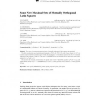Free Online Productivity Tools
i2Speak
i2Symbol
i2OCR
iTex2Img
iWeb2Print
iWeb2Shot
i2Type
iPdf2Split
iPdf2Merge
i2Bopomofo
i2Arabic
i2Style
i2Image
i2PDF
iLatex2Rtf
Sci2ools
76
Voted
DCC
2003
IEEE
2003
IEEE
Some New Maximal Sets of Mutually Orthogonal Latin Squares
Two ways of constructing maximal sets of mutually orthogonal Latin squares are presented. The first construction uses maximal partial spreads in PG(3, 4)\ PG(3, 2) with r lines, where r {6, 7}, to construct transversal-free translation nets of order 16 and degree r +3 and hence maximal sets of r +1 mutually orthogonal Latin squares of order 16. Thus sets of t MAXMOLS(16) are obtained for two previously open cases, namely for t = 7 and t = 8. The second one uses the (non)existence of spreads and ovoids of hyperbolic quadrics Q+(2m +1, q), and yields infinite classes of q2n-1 -1 MAXMOLS(q2n), for n 2 and q a power of two, and for n = 2 and q a power of three.
| Added | 25 Dec 2009 |
| Updated | 25 Dec 2009 |
| Type | Conference |
| Year | 2003 |
| Where | DCC |
| Authors | Patrick Govaerts, Dieter Jungnickel, Leo Storme, Joseph A. Thas |
Comments (0)

